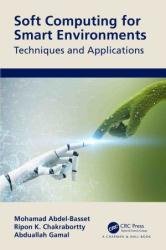 Название: Soft Computing for Smart Environments: Techniques and Applications
Название: Soft Computing for Smart Environments: Techniques and ApplicationsАвтор: Mohamed Abdel-Basset, Ripon K. Chakrabortty, Abduallah Gamal
Издательство: CRC Press
Год: 2023
Страниц: 281
Язык: английский
Формат: pdf (true)
Размер: 15.8 MB
This book applies both industrial engineering and computational intelligence to demonstrate intelligent machines that solve real-world problems in various smart environments. It presents fundamental concepts and the latest advances in multi-criteria decision-making (MCDM) techniques and their application to smart environments. Though managers and engineers often use multi-criteria analysis in making complex decisions, many core problems are too difficult to model mathematically or have simply not yet been modeled.
In response, as well as discussing AI-based approaches, Soft Computing for Smart Environments covers various optimization techniques, decision analytics, and Data Science in applying soft computing techniques to a defined set of smart environments, including smart and sustainable cities, disaster response systems, and smart campuses.
Tiny sensors and processors may now be found in common things because of significant advancements and ongoing shrinking in computer technology. The dream of a smart environment is becoming a reality thanks to incredible advancements in fields such as portable appliances and devices, pervasive computing, wireless sensor networking, wireless mobile communications, machine learning–based decision-making, IPv6 support, human-computer interfaces, and agent technologies. A smart environment is a networked miniature world where sensor-enabled linked objects cooperate to improve the comfort of people’s lives. The terms smart and environment both relate to the capacity for independently acquiring and putting knowledge to use. As a result, a smart environment is one that has the ability to learn and use that information to adapt to the demands of its residents and enhance their experience in that environment. Integrating the Internet of Things (IoT) with smart surroundings has been the subject of several research projects. By enabling the user to monitor the environment from remote locations, the integration of IoT with a smart environment expands the possibilities of smart devices. Depending on the needs of the application, IoT may be integrated with various smart environments. Smart cities, smart homes, smart grids, smart buildings, smart transportation, smart health, and smart industries are the main categories into which the work on IoT-based smart environments may be divided.
Zadeh proposed fuzzy set theory as a mathematical framework to represent the vagueness or imprecision of human cognitive processes. The underlying principle behind the fuzzy set theory is that each element in a fuzzy set has a degree of membership. A membership function that transfers items to degrees of membership within a certain interval, commonly, defines a fuzzy set. In fuzzy logic, several forms of fuzzy membership functions have been utilized. Monotone, triangular, and trapezoidal are the three most prevalent shapes. Because the fuzzy set is a convex function, the trapezoid or trapezoidal function approaches it the best. However, owing to its ease of computation, the triangular fuzzy number (TFN) is more beneficial in fostering representation and information processing in a fuzzy environment. TFN is also the most appropriate feature for expert linguistic assessment, and it is often used in fuzzy multi-criteria decision-making (MCDM) studies.
This state-of-the-art book will be essential reading for both undergraduate and graduate students, researchers, practitioners, and decision-makers interested in advanced MCDM techniques for management and engineering in relation to smart environments.
Скачать Soft Computing for Smart Environments: Techniques and Applications